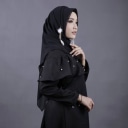Tentang KamiPedoman Media SiberKetentuan & Kebijakan PrivasiPanduan KomunitasPeringkat PenulisCara Menulis di kumparanInformasi Kerja SamaBantuanIklanKarir
2025 © PT Dynamo Media Network
Version 1.103.0
Konten dari Pengguna
Identity of Ideal Women in Film Critical Eleven (2017)
24 Desember 2020 11:36 WIB
Tulisan dari Erlina Puspasari tidak mewakili pandangan dari redaksi kumparan
ADVERTISEMENT
The world of cinema is inseparable from our lives. The film is one of the communication media to convey the message which is depicted through a scene. The story in the film represents the elements that already exist in people's lives because the film records the reality that grows and develops in society, as well as the persuasion of the audience in seeing social reality is. The media has an important role in constructing social reality. According to Trisilowati (2017) in the Journal of Communications entitled Existence and Identity in New Media, it is said that the social space that must be lived creates a new reality, namely identity.
ADVERTISEMENT
According to Schwartz (2001)in International Journal of Theory and Research Vol. 1 Issue 1 entitled The Evolution of Eriksonian and Neo-Eriksonian Identity Theory and Research: A Review and Integration, suggests that identity formation can be described as an interaction of identity attainment and identity confusion. Achieving identity describes an individual who can self-regulate the ideal self-identification, while identity confusion is the inability to develop self-identification that can be applied as a form of adult identity.
According to Hirschman, 1993; Zukin & McGuire, 2004 in Ranjitha G.P & Unnithan, (2018) in a Sage Journal Vol. 7 No.1 entitled Self Identity of Being an Ideal Woman, women have been instructed about what they should be, how they look, image, identity, and the ideal they should represent. Efforts to fulfill the benchmarks of ideal women's identities and their manifestations in their consumption behavior in the media, such as an example of the representation of ideal women shown in the media. This seems to create a benchmark for identity in society and pressure on women to comply with identity standards. Ranjitha G.P & Unnithan, (2018) revealed that women aspire or envy the ideal images portrayed on media.
ADVERTISEMENT
A study from Ariani (2015) in the e-journal of Communication Science found that a film entitled 200 Pounds Beauty was one of the Korean films released in 2006. The romantic comedy genre film tells of a woman who tries to be beautiful to realize her dream of becoming a famous singer and pursuing love, the high number of plastic surgery in South Korea brings the point of view that beauty is the most important thing in social life, including in job competition, education and even marriage in South Korean society. According to Wolf (2004) in Ariani (2015), the ideal figure is someone who is thin, tall, white, and blonde with a smooth face without blemishes, symmetry, and without the slightest flaw.
ADVERTISEMENT
The meaning of the ideal woman is based on the culture in which we live because every country has different social constructions in interpreting ideal women. The ideal woman is depicted based on a social construction in the middle of a society that changes the perspective of society to interpret the figure of an ideal woman. It takes a view that is more directed at the ideal woman in terms of personality. The main focus is on how the media make a picture of the ideal woman in society. One of the films represents the identity of the ideal woman in the film Critical Eleven (2017).
The film Critical Eleven (2017), whose screenplay was written by Jenny Jusuf, Ika Natassa, Monty Tiwa, and Robert Ronny, was then directed by Monty Tiwa & Robert Ronny. In this film, there is a description of the ideal woman characteristics played by Adinia Wirasti as Anya. The depiction of a strong role shows independent women who are known as career women who can position themselves to stand on their own feet, insightful woman, independent women, educated woman, have principles, humble, responsible woman, women who try to solve problems to get out of problems, women who keep a cool head during a tense situation, an open-minded woman, and she doesn't try to act like someone she's not.
ADVERTISEMENT
According to Thadi (2018) entitled Image of Women in Media in the Syiar Scientific Journal Vol. 14 No. 1, conveyed that the media is a reflection of the situation around them, it also shapes social reality, the media rarely displays women significantly both in the world of work and in public life. The media makes women more of the objects of presentation. It is very difficult to say that women are equal to men. The film Critical Eleven (2017) represents the real-life that occurs in society, where many women are starting to be active and visible in the public space. This happens because currently women are concerned with education to improve academic achievement and soft skills so that they can have a career in the world of work to become career women. In this film, there is also gender equality in the work environment where a woman can become a leader and is given the right to work outside the home. The personality described is clear that the representation of the ideal woman is not only physical but is shown in personality.
ADVERTISEMENT
Impressions of the representation of ideal women are identical to the physical ones that refer to height, direct body shape, light skin color, perfect skin types, etc. This tendency is the basic value of the media in representing women, such as movies, advertisements, news, magazines always presenting women who are ideal when viewed from their beauty, body size, and physical shape. When compared in Critical Eleven, this difference shows, in addition to the physical appearance shown by the ideal female, which is shown through her profession in the public room as a leader, the way she dresses, the way she communicates, shows an insightful woman, interacts with people around her, her attitude shows that she is an intelligent and educated person. This shows that beauty is not only seen from the outside but can be seen from within herself and her personality.
ADVERTISEMENT
The solution requires a different point of view in interpreting a social construction formed by most media. The media can create a non-discriminatory image and accentuate the physicality of women. Media can build a social view that women also have the same abilities as men when given public space and opportunities. The ideal woman should be seen from her personality and attitude as a woman. Because later on, women are the main key in producing young people with good personalities. The formation of this view needs to be continuously displayed in the media because the role of the media can shape and change the views of women in front of society.
ADVERTISEMENT
Erlina Puspasari
(Student of Communication Studies, Muhammadiyah University of Surakarta)

